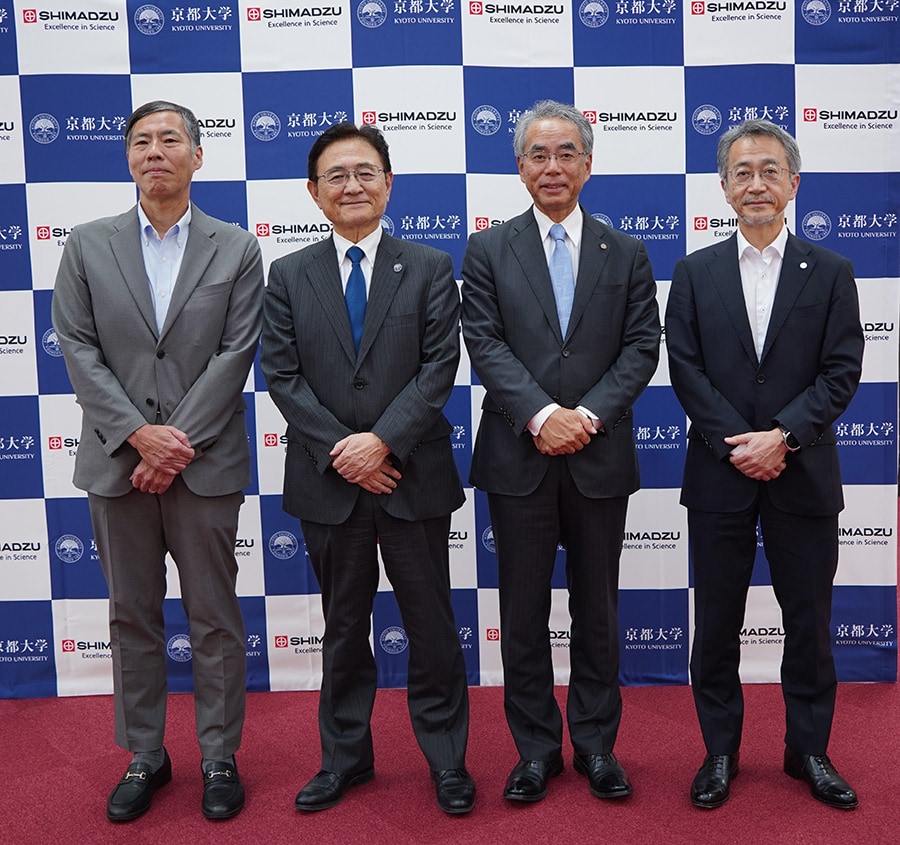The Wisdom of Kyoto University and the Technology of Shimadzu: Paving the Way to a Global Future with Innovative Co-Creation New Comprehensive Collaborative Agreement Signed with Kyoto University
Shimadzu Corporation and Kyoto University (Yoshida-honmachi, Sakyo-ku, Kyoto-shi) have signed a comprehensive collaborative agreement with the objective of creating new business activities and innovation to contribute to solving social problems, and training global high-level human resources. In 2022, both parties signed a three-year comprehensive collaborative agreement with the objective of creating new business activities by acquiring innovative technologies to contribute to solving social problems, and training human resources in the social implementation of these new business activities. They have taken initiatives in the areas of healthcare and green innovation, including searches for business-related themes, and collaborative research. On this occasion, they have expanded the previous agreement by signing a new comprehensive collaborative agreement. The objective is to expand research objectives in the four so-called social value creation domains Shimadzu Corporation is targeting (healthcare, green, material, and industry), and at the same time, to strengthen collaborative research integrating the arts and sciences. This agreement is for a five-year period.
From the left, Koji Murota, Deputy Executive Director of Kyoto University and Director-General, Office of Institutional Advancement and Communications; Dr. Nagahiro Minato, President of Kyoto University; Yasunori Yamamoto, President & CEO of Shimadzu Corporation; and Takahiro Nishimoto, CTO and Managing Executive Officer of Shimadzu Corporation
In this new collaborative agreement, initiatives will be taken in accordance with the previous goals of creating new business activities by acquiring innovative technologies to contribute to solving social problems, and training human resources in the social implementation of these new business activities. In addition, the parties will begin a preeminent research promotion project to pave the way to the society of the future, and a project to create social value through data utilization*. For the former project, both parties are involved in cooperative research initiatives with Professor Yukiko Uchida, Director of the Kyoto University Institute for the Future of Human Society, and Professor Koji Hashimoto of the Kyoto University Graduate School of Faculty of Science. The objective is to promote research that integrates the natural sciences, humanities, and social sciences, with preeminent researchers at Kyoto University, recommended by administrators at the university and Shimadzu, with an eye to the well-being of people and the planet in 2050. For the latter project, Shimadzu will make a broad public appeal for research seeds capable of creating social value by utilizing data from Kyoto University. The aim is to create innovative technology and new business opportunities through collaborative research in four so-called social value creation domains at Shimadzu.
Additionally, in the project to create active human resources, in addition to REACH Project Career, a previous initiative to dispatch Shimadzu employees to Kyoto University, REACH Project Straight will be starting. In this initiative, university students are hired by Shimadzu at the completion of a Master’s program, and are dispatched as employees to Doctoral programs. Further, both parties will utilize their respective international sites to train human resources capable of acting internationally and to deploy active support globally.
- *Research in which large amounts of data are collected and analyzed, and hypotheses are formulated based on the results. These hypotheses are then verified, leading to new findings and knowledge.


